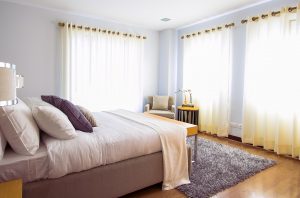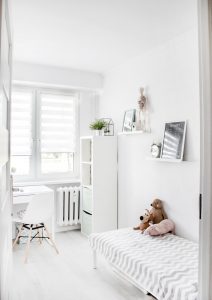By: Guest Blogger Jenny Wise
Your bedroom should be a sanctuary, the place where you go to get away from the world and relax. This is especially true for people with autism, for whom the wider world is often filled with  overwhelming stimuli that make it difficult to unwind.
overwhelming stimuli that make it difficult to unwind.
A great autism-friendly bedroom should feel calm, pleasant, and safe, and how to achieve this will depend greatly on your specific experiences. However, these six features are a good place to start, as they are important considerations for many people with autism.
1. Lighting
The type of lighting you use in your bedroom is key for a relaxing experience. Many people with autism are particularly sensitive to humming or flickering lights, such as fluorescents, so these are a definite no-no. According to Autism Parenting Magazine, adjustable LED lighting is a great option for children’s bedrooms, and this applies to adults as well.
2. Curtains
Curtains have multiple creative uses beyond keeping light out. They can also be used as room dividers; for example, dividers are great for children sharing their bedrooms with a sibling and who could benefit from a separation of spaces. You can also use curtains to create a peaceful, relaxing space in another area of the house, such as the living room, or to designate a bedroom space if you live in a studio flat.
3. Colors
The colors in your room can have a huge impact on your mood, so stay away from aggressive or stimulating shades like red, orange, or yellow. Pale, cool tones of blues and purples are a soothing option, as are neutrals like off-white and beiges. House Beautiful has some great pictures and suggestions to help get you inspired.
Many people with autism experience feelings of anxiety in messy, chaotic environments. As such, bedrooms should be designed for optimal organization, with a defined place for everything and ample storage space. If you don’t have a lot of room to work with in your home, look for some creative storage solutions that can help you make the most of it.
You should also carve out five to 10 minutes in the morning or evening to make sure everything is in its place — you will be thankful for it when you are too tired or too anxious to tidy.
5. Sounds
Some people are lucky enough to live somewhere quiet and peaceful, but for many city dwellers, that is not an option. Sounds from the street or the general neighborhood can be an anxiety trigger for people with sensory sensitivity, but there are a few easy ways to keep the noise out. If these don’t work, invest in a high-quality pair of noise-canceling headphones — you can even get models that double as comfortable eye masks for optimal nighttime comfort.
6. Bedding
Only you can know which textures feel good for you, so have some fun exploring different fabrics, thicknesses, and thread counts for your bedding until you find what you like. You can also look for bedding with cooling features if you tend to get too hot at night — in particular, look for pillows, comforters, and mattresses that help with this.
If, on the other hand, you tend to get cold, many people with autism have also found weighted blankets to be particularly beneficial, as they create a soothing sensation of being held down.
Of course, everyone’s autism-friendly bedroom will look different. Sensory sensitivity affects people in a variety of ways, so what works for you could be a nightmare for someone else. The important thing is to not be afraid to personalize your bedroom to your exact needs: of all the rooms in your home, this one should be designed for you. Include anything that makes you feel comfortable and at ease, and banish any anxiety triggers that could keep you from relaxing and sleeping well. Trust us, the effort is well worth it.
Jenny Wise created Special Home Educator as a forum for sharing her adventures in homeschooling and connecting with other homeschooling families.






1 Comment
Thank you, this is a helpful article.